“A Kind of Spy”: The Secret Life of Vivian Maier
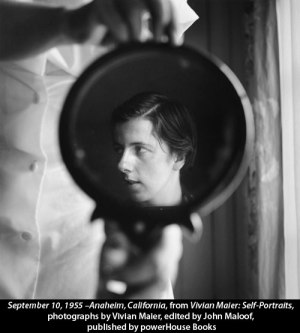 Who was Vivian Maier? She could be described the way Churchill once spoke of Russia, as “a riddle wrapped in a mystery inside an enigma.” A prim, foreign-accented woman, Maier worked as a nanny in a series of Chicago households from the 1950s to the 70s. One of her non-negotiable requirements at any job was a secure lock on her bedroom door, and only after her death was it discovered that this highly private woman was a great street photographer—ranking with such masters as Helen Leavitt and Garry Winogrand. Compulsive and prolific, Maier never showed her images to anyone, and when she died, she left thousands of them undeveloped.
Who was Vivian Maier? She could be described the way Churchill once spoke of Russia, as “a riddle wrapped in a mystery inside an enigma.” A prim, foreign-accented woman, Maier worked as a nanny in a series of Chicago households from the 1950s to the 70s. One of her non-negotiable requirements at any job was a secure lock on her bedroom door, and only after her death was it discovered that this highly private woman was a great street photographer—ranking with such masters as Helen Leavitt and Garry Winogrand. Compulsive and prolific, Maier never showed her images to anyone, and when she died, she left thousands of them undeveloped.
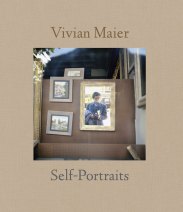 I wrote about Maier here last year, concluding that “we’re bound to hear more” about her. Now, sure enough, comes a trifecta of cultural events about the secretive photographer, from the movie Finding Vivian Maier to two new shows of her work at the Howard Greenberg Gallery and a monograph, Vivian Maier: Self-Portraits
I wrote about Maier here last year, concluding that “we’re bound to hear more” about her. Now, sure enough, comes a trifecta of cultural events about the secretive photographer, from the movie Finding Vivian Maier to two new shows of her work at the Howard Greenberg Gallery and a monograph, Vivian Maier: Self-Portraits from powerHouse Books (a follow-up to the 2011 monograph Vivian Maier: Street Photographer
).
Last weekend, I attended the U.S. premiere of Finding Vivian Maier at the DOC NYC festival—described as “the hottest ticket” of a festival filled with great documentaries. The film is both unsettling and delightful, probing the mystery of Maier’s life and offering a compelling, bittersweet portrait of a very complicated woman. In the words of Charlie Siskel, who co-directed the movie with John Maloof, “If [Maier’s] photographs were just okay, it would still be a great story.” The fact that her photographs are brilliant is the icing on the cake.
Of course, the biggest question about Maier—which the movie explores in depth—is why she never sought an audience for her work. John Maloof, the young man who discovered her after buying a random box of negatives at a community auction, is haunted by this question. He tracks down and interviews people who employed Maier, and children she looked after. He consults well-known photographers about the quality of her work.
The stories that emerge are fascinating and sometimes contradictory. A veritable Mary Poppins figure to some of the children she worked with, Maier was abusive to others. She was extremely wary of men, in a way that suggested she might have been abused herself. Often she refused to give her name and occupation to people, referring to herself as “the mystery woman” or “a kind of spy.”
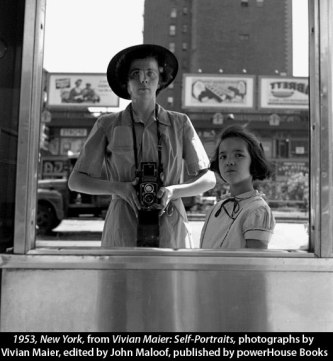 From the interviews, one thing seems clear: Maier became a nanny in order to feed her photographic aspirations. Unlike working as a seamstress (which she’d done before), being a nanny allowed her to spend much of her time taking pictures outdoors. Her grown-up charges remember being dragged from their safe suburbs to sketchy Chicago neighborhoods, where they were sometimes left to fend for themselves while their nanny scurried off to take photographs.
From the interviews, one thing seems clear: Maier became a nanny in order to feed her photographic aspirations. Unlike working as a seamstress (which she’d done before), being a nanny allowed her to spend much of her time taking pictures outdoors. Her grown-up charges remember being dragged from their safe suburbs to sketchy Chicago neighborhoods, where they were sometimes left to fend for themselves while their nanny scurried off to take photographs.
Though she often comes across as a frosty outsider (there’s a lot of speculation in the movie about her accent), Maier was clearly engaged and persuasive with people. Her bottomless curiosity led her to interview and record people in supermarket checkout lines, and there’s an intriguing scene in the movie where she asks a woman to speak on tape about politics. “Come on,” she urges with a laugh, “women are supposed to be opinionated—I hope.” This mixture of humor, flattery and interest shows a woman who knew how to get what she wanted from people.
“Wow,” said filmmaker Michael Moore after the screening, in a Q&A session with directors Siskel and Maloof (who he was responsible for bringing together), “people are really going to like this movie.” What made the film so successful, Moore suggested, was that “the world is filled with people who write and paint and take photographs, and who know their voice will never be heard. Yet… nobody wants to be forgotten.”
A Michael Moore appearance wouldn’t be worth spit without a few rants, and Moore was happy to oblige. He lobbed one grenade at the moneyed/nepotist classes (“if you’re working class and don’t have an uncle in the business, it’s hard to be discovered”), and another at the American impulse to medicate away mental illness (“some of the most creative people I’ve met are crazy…we wouldn’t get the art if we expected them to line up on the assembly line…in some ways you have to welcome the crazy, not keep drugging our kids.”)
By contrast, Maloof was modest and restrained. In the movie, he’d confessed, “I can’t help but feel a little uncomfortable or guilty, exposing the work of someone who didn’t want to be exposed.” Part of the discomfort, no doubt, is the fact that he stands to reap a huge fortune from Maier’s archive—yet if anyone is going to do this, I’m glad it’s this sincere, responsible young man. He talked eloquently about Maier’s virtuosity, and said her work had inspired him to study photography himself. Asked by an audience member about copyright issues, Maloof said he’d come to an arrangement with the photographer’s living relatives. “You’re due every dime you get, for making sure her work gets out there,” Moore told him.
 Of the 150,000+ negatives Maier exposed during her life, the majority were of other people and scenes, but a significant number were self-portraits—which would seem to bear out Moore’s suggestion that, like most people, she wanted to be seen and remembered, if only by herself. Many of those self-portraits have just been published in the monograph Vivian Maier: Self-Portraits
Of the 150,000+ negatives Maier exposed during her life, the majority were of other people and scenes, but a significant number were self-portraits—which would seem to bear out Moore’s suggestion that, like most people, she wanted to be seen and remembered, if only by herself. Many of those self-portraits have just been published in the monograph Vivian Maier: Self-Portraits, and some are now on show at the Howard Greenberg Gallery.
In mirrors, windows, and car hubcaps, in the shadows she cast on beaches and brick walls—Maier resolutely puts herself in the frame. The emotional range of these images is quite wide. Some seem plaintive—Maier is isolated, severe, lonely. In others she seems happy, and some are appealingly whimsical—as, for example, when she photographs her shadow on the beach with a horseshoe crab where her heart should be.
As Maloof writes in a foreword to the book, though we may never know who Vivian Maier really was, we can at least see her through the “unique confession” of her self-portraits. And there we see a fully realized, complex individual—sometimes playful, sometimes withdrawn. Even at her most morose, though, Maier never stopped being creative, looking for unique angles and settings that would come together into a perfect composition.
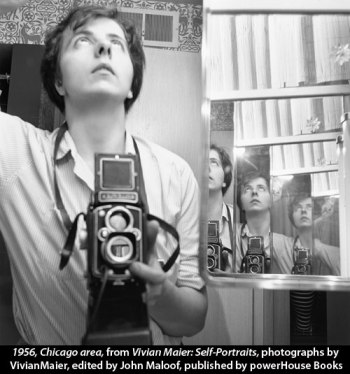 Unfortunately, Maier’s life story didn’t end well. As she got older she became increasingly peculiar and paranoid, hoarding piles of newspapers and junk, begging for friendship, alienating people. In the community where she died, she was remembered as an eccentric, a batty old woman sitting alone on a park bench. If the younger Vivian Maier had passed this woman by, surely she would have stopped to take her photograph.
Unfortunately, Maier’s life story didn’t end well. As she got older she became increasingly peculiar and paranoid, hoarding piles of newspapers and junk, begging for friendship, alienating people. In the community where she died, she was remembered as an eccentric, a batty old woman sitting alone on a park bench. If the younger Vivian Maier had passed this woman by, surely she would have stopped to take her photograph.
24 comments on ““A Kind of Spy”: The Secret Life of Vivian Maier”
Leave a Reply
Connecting to %s

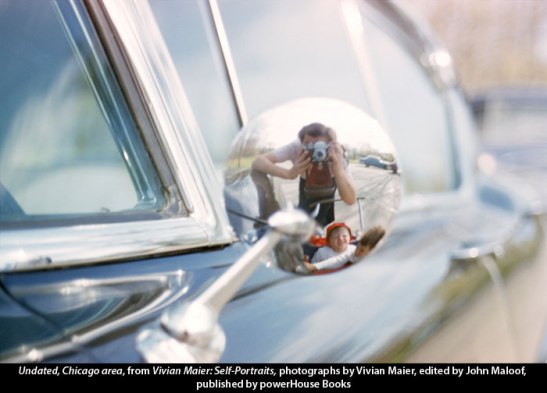
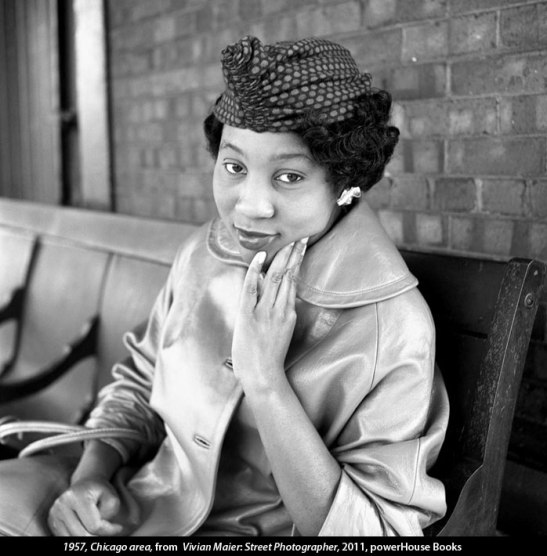
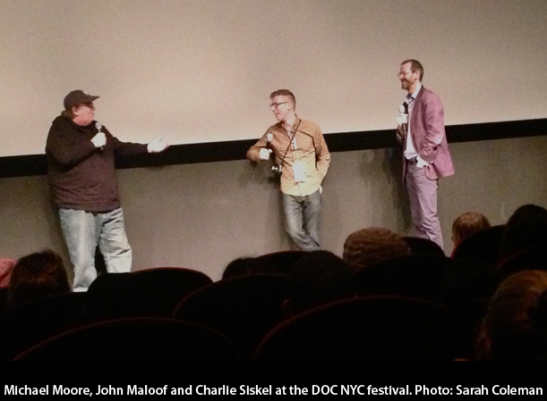

What a fascinating figure, Sarah. The secrecy adds a whole other layer to this brilliant photographer. I’ll be sure to check out her exhibit at the Howard Greenberg Gallery. Thank you for the nice write-up.
Thanks, Amy! Let me know if you want to go together. I was there yesterday but would go again.
“If the younger Vivian Maier had passed this woman by, surely she would have stopped to take her photograph.” A nice summing up, although I still have my doubts. Not about the quality of her work, but mostly about the hype created around it. I mean that maybe people outside the circles of photography might be introduced to her work, mainly due to the story it was found, and still ignore major (or even minor) photographers with equally or better work.
To better understand what I mean, on the teaser of the film, the final piece of interview, reveals a part of the story that is not very healthy in my opinion.
“I wish i would have found these negatives instead of you”!?
Thanks for your comment, Vassilis. I agree that there is something profoundly uncomfortable about the posthumous celebration of Vivian Maier. One person in the movie says something like, “Vivian would have hated all of this,” by which I think she meant all the probing into motives and personality. And it’s so sad, too, to think that Maier died in poverty when there’s clearly a huge market for her work (though this has happened to other photographers too!) But I do think her work stands up to the hype. In the Q&A session after the movie, someone pointed out that she had an “astoundingly high hit rate,” and Maloof confirmed that she was “very frugal”—she couldn’t afford rolls and rolls of film, so she had to make every shot count, and she did. How different from the “spray and pray” approach allowed by today’s technology!
Lacking time is the new limit for recent photographers.
Hi, The writing is really excellent, as is the writing other articles I have read by you. As a street photographer, your article helps spurs more street journeys and more viewing of street photographers I might not of heard of yet. One of Maier’s self portrait shots into a car mirror reminds me of a favorite Eliot Erwitt photograph with a woman, seen in the car mirror, during a kiss.
Best Wishes,
Alan Kritzler
I know the Erwitt photograph you mean, Alan. A classic! It’s dated 1955, so Maier might have seen it by the time she shot the above color image. She also did at least one other self-portrait in a car mirror in black & white in the 50s. I can’t find that shot online, but if you visit the Greenberg gallery you’ll see it.
When will this film be available to the general public and how can it be accessed?
Karen: I’m not sure if it has a U.S. distributor yet. According to the news section on the official Vivian Maier website (http://www.vivianmaier.com/news/), the film has so far been bought in several European countries and in Canada. I’m very confident that it will get a distribution deal in the U.S. soon, and/or play on U.S. television. Tune in to the above link for news.
Thank you Sarah. I hope it makes it to the US I really really want to see this film!!
Officially obsessed with this “mysterious” woman! Hope I get a chance to see the film as well.
Audrey and Karen: I just heard from one of the filmmakers, Charlie Siskel, that the movie will be in U.S. theaters in March 2014. Not too long to wait!
Nice! I anticipate it!!!
Hello from Italy.
I liked very much your post: a really nice homage to the memory of Vivian Maier.
Everybody interested should have a look at the first book about her as a street photographer. I think it gives a genuine, intelligent and sometimes even ironic view of something missing from our everyday life: simplicity.
Ciao
Thanks, dasar. I agree with you that ‘Vivian Maier: Street Photographer’ is a better introduction to Maier’s work than ‘Vivian Maier: Self-Portraits.’ I’m also intrigued by a third book, ‘Vivian Maier: Out of the Shadows,’ which is drawn from a different (slightly smaller) collection of Maier’s work, and contains several essays. I haven’t seen it yet but plan to look at it soon.
Dear Sarah,
Great article. Fascinating subject. “Haunting” is the word.
I wonder why she called herself “A kind of spy”? Did she take photographs of other people clandestinely? Spy was hardly a word to use about yourself in the post-Rosenberg era.
I will look out for the film in Britain.
Yours haunted,
Michael
Thanks, Michael. Yes, she did take some of her photos clandestinely — she had a Rolleiflex camera that she could hold at waist level, so it wasn’t obvious she was taking a photo. Others were clearly collaborative. It’s interesting to contrast her with another 1950s photographer I wrote about, Angela Calomiris, who actually WAS a spy!
Reblogged this on pinkpressthreatfiles.
Thanks for the notification, MrTulip!
Great blog. I love the way you analyse thhe work. Liked the Arnade one as well, in spite of dear old Lucent!
Thanks, fungalspore! Do I take it from your name that you’re keen on mushrooms?
Thank you for the insights you shared on this fascinating and talented individual. Her work is stunning.
You’re welcome! Thanks for stopping by.
Normally I detest Michael Moore and everything he represents, but that said, I do – indeed – have to agree with his statement to the effect that if you don’t have an uncle in the business you will not be discovered. Vivian Maier’s work and its discovery makes me wonder how many (probably thousands) REALLY GOOD photographers will never be discovered and receive the recognition they are due simply because they are not “in the business” or were not wealthy enough to buy recognition.